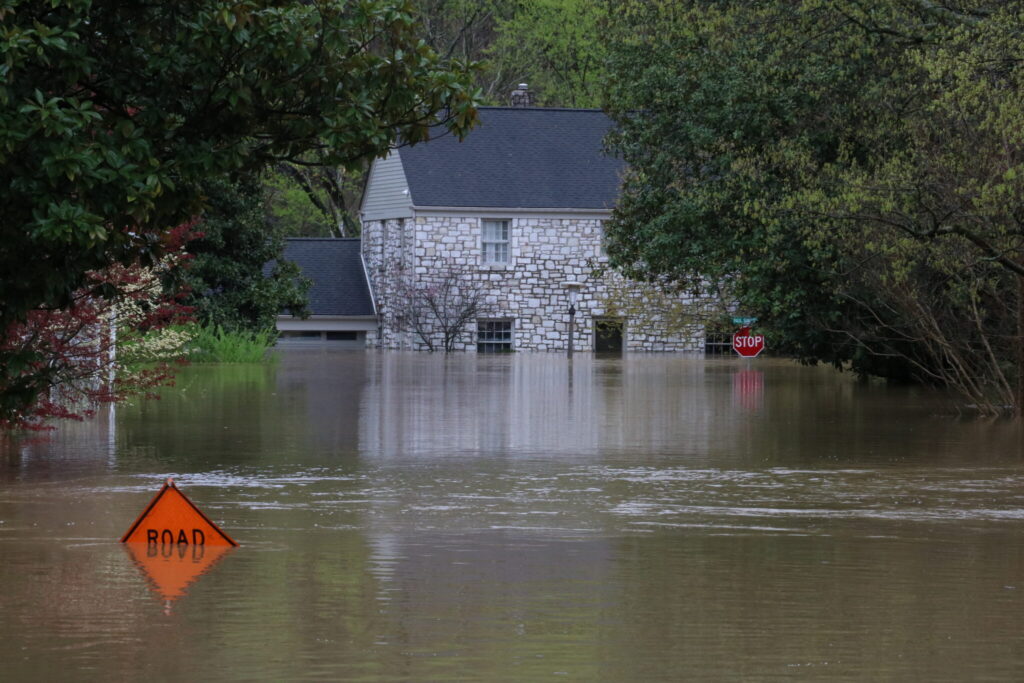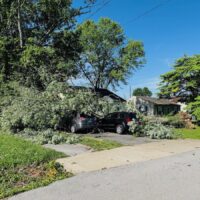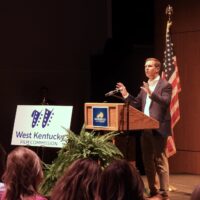An increasingly warming climate intensified the deluge of rain that fell on Kentucky and other states in early April, according to a new report from a multinational academic group that studies climate change’s connections to extreme weather events.

Torrential downpours inundated communities across Kentucky in early April, with some parts of Western Kentucky receiving more than a foot of rain in just four days. Some waterways including the Kentucky River in Frankfort crested at near-record highs as Kentuckians were forced to evacuate low-lying homes and businesses. Dozens of counties declared states of emergency, hundreds of roadways were closed and Gov. Andy Beshear said the storms were responsible for the deaths of seven Kentuckians.
A report from World Weather Attribution found, based on climate modeling, that the extreme rainfall across Kentucky and seven other states was about 9% more intense because of warming, driven by the burning of fossil fuels, that already has occurred.
Climate change increased the likelihood of the extreme rainfall — which pulled its moisture from a significantly hotter Gulf of Mexico — by about 40% compared to a cooler climate according to the report. The likelihood of such a rainfall event is still relatively rare, the report authors found, at about a 1 in 100-year event.
Bernadette Woods-Placky, a chief meteorologist at the New Jersey-based nonprofit research organization Climate Central, said in a Wednesday briefing that it’s hard to discern how climate change impacted flooding in specific waterways and communities without studying the hydrology of each area.
But she said an increase in flooding intensity, even if marginal, can be significant when talking about a “tipping point” of whether a river crests a bank or barrier that’s holding it back.
“If you hit that tipping point, then it floods over to everything. And so the littlest bit in certain areas can make a huge impact,” Woods-Placky said. “A warmer atmosphere forces more evaporation, so our atmosphere in general has more water to come down whenever there’s a trigger, wherever there’s a trigger. So that’s why we’re seeing, overall, an increase in heavy rain events.” Basil Griffin Park in Bowling Green remains inundated on April 7 after days of heavy rain. (Kentucky Lantern photo by Austin Anthony)
Friederike Otto, an author of the report and a senior lecturer in climate science at Imperial College London, said while the methods used in the report have been peer reviewed, the study on the April rainfall has not yet been peer reviewed.
Based on modeling, the report predicts that if current climate policies across the globe remain consistent, the climate will warm by approximately 2.6 degrees Celsius by 2100; in that case, extreme rainfall events “are expected to approximately double in likelihood again” and further increase in intensity by another 7%. Earth recorded its hottest year on record in 2024, crossing a warming threshold of 1.5 degrees Celsius that the Paris Climate Agreement of 2015 aimed to avoid exceeding.
Otto, the report author at Imperial College London, said significant increases in the likelihood of such weather events from climate change could also compound the costs of recovery in communities hit repeatedly by flooding. If recovery from an extreme weather event costs billions of dollars, having it happen again could transform “what extreme weather can mean for a community.”
Those speaking Wednesday also commended the National Weather Service’s preparedness and early warnings of the incoming weather last month across multiple states, saying it was vital in protecting people and property.
Woods-Placky advocated for the national agency in light of reporting that multiple NWS offices across the country, including three offices covering almost the entirety of Kentucky, were without a chief meteorologist to lead teams of forecasters and other staff.
“They did some tremendous work, and they did save lives,” Woods-Placky said. A dog walker pauses to photograph a flooded neighborhood street on April 7, 2025 in Bowling Green. (Kentucky Lantern photo by Austin Anthony)
This article is republished under a Creative Commons license from Kentucky Lantern, which is part of States Newsroom, a network of news bureaus supported by grants and a coalition of donors as a 501c(3) public charity. Kentucky Lantern maintains editorial independence. Contact Editor Jamie Lucke for questions: info@kentuckylantern.com. Follow Kentucky Lantern on Facebook and Twitter.
Liam Niemeyer covers government and policy in Kentucky and its impacts throughout the Commonwealth for the Kentucky Lantern. He most recently spent four years reporting award-winning stories for WKMS Public Radio in Murray.





